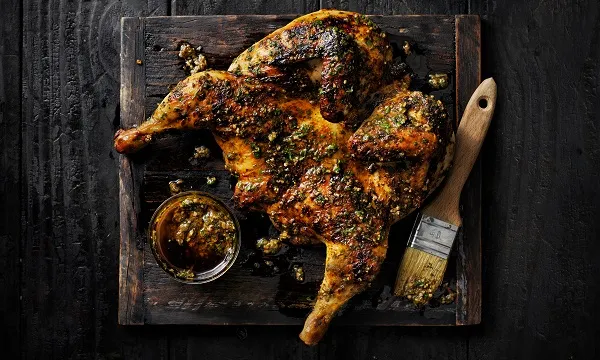
Will premium chicken lead the segment's next growth phase?
Executives from Oporto, NeNe Chicken and General Chicken Co talk about their views on what’s happening in the category.
Fried, roasted, braised or grilled - chicken remains one of the staples for time-poor consumers’ increasing pursuit of quicker meal alternatives.
The category itself is making noise in other markets, with a crispy sandwich in mid-August sparking the so-called chicken wars between restaurant chains in the US, whilst a fast food giant made headlines by launching its take on plant-based chicken.
In Australia, industry expansion remains at a steady pace, but is being constrained by tightening internal competition amongst fast food operators, the rising awareness of dietary health and nutrition and external competition from supermarket chains like Coles and Woolworths with their expanding prepared meal offerings.
Players within the space, big and small, have relied on technology and proactive product development to respond. Oporto for example, launched its Pulled Chicken Bowl product to address the continued trend towards healthier alternatives and has made their chicken more accessible through boxed meals.
“The QSR sector as a whole is really leaning towards the convenience of delivery. This means food innovation that tastes great and travels well to deliver the best customer experience possible. Time-poor consumers [are] looking for both whole meal solutions & ‘on the go’ snacking solutions,” Oporto marketing head Samantha Bragg explained to QSR Media.
VIC-based General Chicken Co director Nuri Sadiku agrees, stressing that third party aggregators have “disrupted the space”, both for traditional operators and consumers. The concept says it plans to mainstream organic, free-range chicken to the market in a “structured and cost-effective manner.”
“Digital interactions and marketing has replaced the old flyer or booklet specials and offers that people collected,” he explains. “Apart from pizza and maybe some Asian food, chicken products do pass some tests when delivered in their original or whole state.”
Aside from easily accessible home delivery options, NeNe Chicken Australia general manager Richard Godwin argues that customers are preferring brands with multiple payment options.
“To meet these demands, NeNe recently introduced WeChat [Pay] and Alipay payment systems; we partner with the major delivery platforms and maintain a consistent focus on a quality offering,” he said.
Outside factors and trends reshaping the industry aside, all three executives agree: this game of chicken, so to speak, banks on the category’s constant options for variety and affordability compared to other forms of protein.
“Chicken is a great protein base for innovation, it can be transformed through bastings and various cooking platforms,” Bragg said.
“Korean, Portuguese, Fried Variants - it all keeps it interesting for the consumer. Then, you have the rising segment of prepared meals; this is a steadily growing market that is also another avenue for time-poor people to plan ahead and cater for their or their families needs in advance,” Sadiku explained. “Chicken forms a majority of styles and offerings...you either eat it cold as with a side salad or re-heat a[s] a meal replacement.”
“The best thing about the QSR chicken industry is its stability as a consumer staple. It never goes out of fashion, it is a sustainable source of comfort food. In addition, significant price increases in other forms of protein such as beef and pork have increased demand for chicken which is still regarded as being more affordable,” Godwin added.
More chicken for Aussies
The numbers tell the same story.
According to Craveable Brands’ ‘Chicken Is King’ report, the average Aussie eats 49 kilograms of chicken annually, twice as much chicken as beef and pork, and six times more than lamb.
The price of chicken, specifically, increased by 26% between 1994 and 2017. Lamb and beef, however, spiked by 162% and 93% respectively.
69% of Aussies prefer to eat their chicken at the dinner table. Queenslanders are most likely to prefer roasted chicken, Victorians prefer chicken breasts whilst people from NSW are most likely to eat their chicken barbequed and prefer thighs and wings.
IbisWorld research forecasts industry revenue to grow at an annualised 0.5% over the five years through 2023-24, to be worth $3.3bn.
Segment growth, one of their analysts explains, lies in premiumisation - a pattern similar to other mature categories in the industry.
“Greater importance has been placed on the quality of ingredients and premium meals. For the QSR chicken scene this has meant sourcing hormone-free and RSPCA-approved poultry meat. Additionally, smaller, boutique outlets have opened offer burgers with a range of combinations and different bread options such as wraps and brioche buns. Outlets such as Nando’s and Red Rooster have seen their market share impacted by these newer options such as Schnitz and Oporto,” IbisWorld senior industry analyst Matthew Reeve said.
Citing the popularity that swarmed the new Popeye’s chicken sandwich, he argues further that premiumisation is going beyond the Australian market.
“It is not slowing down, with customers eager for new options,” he added. “The selling out of KFC’s Beyond Chicken is [also] emblematic of the increasingly global vegan trend. This has been spurred on in part by rising health consciousness, as well as increased concern for animal welfare and the environment.”
To ensure their footing in the sector, Reeve warns that traditional chains must ensure that they source premium and ethical poultry.
“Cooking style must also be taken into account, with shallow-fried or grilled chicken now preferred to the more traditional deep-fried method,” he added.
Banking on flexibility
Bragg believes that the segment will see further growth, both served on the bone as well as in burger formats.
“I believe the chicken category will continue to grow strongly as many consumers look towards reducing their red meat consumption coupled with the affordability & flexibility of chicken,” she said.
Oporto says it is looking to alternative chicken products for possible snacking options “to suit the fast-paced lifestyle of our consumers.”
Teasing two new sauce coatings in November and March 2020, NeNe remains confident in their classic range and selection of wingettes, drummettes, burgers and wraps.
“Australia's demographic is incredibly broad, however chicken as a source of protein is widely consumed amongst all demographic groups. Chicken is also regarded [as] healthier meat than red meat,” Godwin said.
Sadiku, meanwhile, believes that free-range chicken may become the next step for the segment.
“I believe that the customer will continue to push for better quality products and be okay to pay for it if it meets their expectations. Free range may become the benchmark as opposed to normal or non-free range/RSPCA approved; the difference is great in bird quality, the price is worth it.”
























